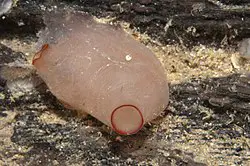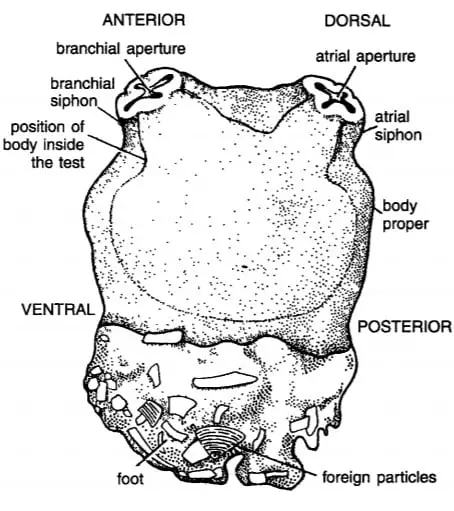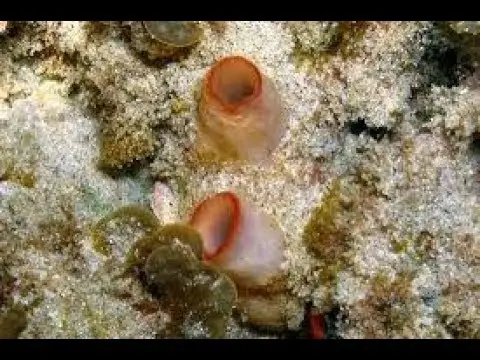Table of Contents
Live in Marine Environment:
Members of the subphylum Urochordata generally live in marine environments and in almost all parts of the world they are observed. Urochordata lives in all depths of the ocean, shallow coastal areas as well as deep oceans.

They are Sedentary As Well As Pelagic: Most of the Urochordata are fixed at the oceanic floor and collect food and oxygen from the ocean bottom. For example Herdmania, an important example of subphylum Urochordata live at oceanic floor fixed, they are sedentary. But some members of the subphylum Urochordata also free-swimming.
They Form Colony or Live Solitarily:
Most of the members of subphylum Urochordata spend solitary life, for example, Herdmania live generally in a solitary state. But sometimes a large number of members of subphylum Urochordata live at a certain place together and form a colony.
Size:
Different members of subphylum Urochordata show different sizes, very small size members of around 0.2 mm are available as well as much larger size in cm also observed. Sometimes the size may reach over 12 cm as seen in some species of Herdmania.
Shape:
Like size, Herdmania shows great variation in shape also, some members even do not have a specific geometrical shape, Herdmania has a potato-like pouch-shaped due to their outer tunic covering.
Coloration of Urochordata:
Colour in members of Urochordata is variable, but in Herdmania it is pinkish. The highly vascular supply to the test makes the test a pinkish appearance and the vascular ampullae on the test give red tints on the pinkish background.
External Appearance of Urochordata:
Urochordata body does not show metameric segmentation, body is unsegmented. There are no paired appendages. The body is sac-like in external appearance, the upper surface of the body is wrinkled, tail absent.
Urochordata Undergoes Retrogressive Metamorphosis:
In the larval stage, some advanced features are present but during metamerism, the larva is under degeneration due to retrogressive metamorphosis. After the larval stage adult stage lack some important features which were present in the larval stage.
Body Covered by Tunic Covering:
In Urochordata, the external wrinkled sac-like appearance is due to the outer tunic covering. The tunic covering give the animal protection against external injuries and form foot to provide anchorage to the oceanic floor. The tunic covering is made of a polymer known as tunicate, it is polymer like cellulose. Due to this tunic covering, members of Urochordata are also known as Tunicata.
Atrial Aperture and Branchial Aperture:
At the free end of the tunic, two tube-like structures are present, one is known as atrial siphon while another one is known as a branchial siphon. The atrial siphon opens outside through the atrial aperture, it acts as a cloaca or outgoing canal in most of the Urochordata. Branchial siphon opens outside through branchial aperture which acts as mouth opening and water current enters into the body through this opening from which the animal gets nutrition and oxygen.

Coelom Absent:
True coelom or body cavity absent in Urochordata, a body cavity present but it is lined by ectoderm. This ectoderm lined body cavity is known as the atrial cavity which opens outside through the atrial siphon and atrial aperture.
Notochord Present only in Larval Tail:
Notochord does not present an entire length of the body, in the larval stage the notochord is only present in the tail region which gives the tail mechanical support. In the adult stage, the animal undergoes degeneration, due to the limitation of the notochord in the tail region in the larval stage this group of animals is known as Urochordata.
Alimentary Canal is Complete:
In Urochordata alimentary canal is complete, the mouth leads to the pharynx, two to several pairs of gill slits are present at the wall of the pharynx. The pharynx is much larger and forms a large cavity, it has an endostyle structure.
Respiration in Urochordata:
The test is highly vascularized, so they easily carry gaseous exchange through the test, gill slits also take part major role in respiration.
Blood Vascular System in Urochordata:
Urochordata have an open type of blood vascular system, the heart is tubular and present on the ventral side of the body. In the blood of Urochordata, a special type of cell is presently known as vanadocytes which are able to extract vanadium from the ocean water and store it.
Excretory System in Urochordata:
Excretion majorly occurs through the neural gland but other structures like nephrocytes, pylori gland also take part in excretion.

Reproduction and Development in Urochordata:
In Urochordata both male and female reproductive systems are present on each individual, so they are hermaphrodites. But they show protogyny so self-fertilization is absent, cross-fertilization occurs, development is indirect. In development, free-swimming tadpole larva present and they show retrogressive metamorphosis.
Reference Urochordata Classification Morphology Characteristic Features
Detailed Information on
Habitat and Habits of Herdmania
External Morphology of Herdmania
Mantle Viscera and Coelom of Herdmania
Blood Vascular System of Herdmania
Hi Everyone!!! Welcome to Imaluop. Imaluop always try to learn some new and he want to share to other people. Here we will try to learn various topics on Science, specially on Biological Sciences.